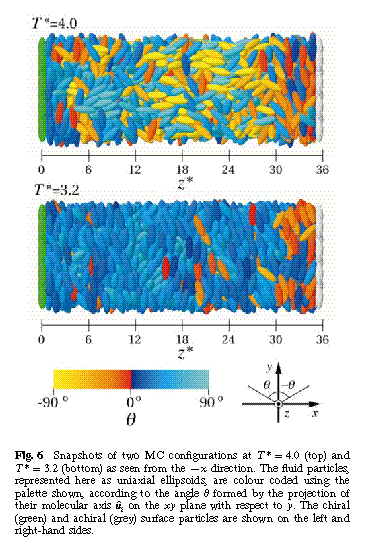
R. Berardi, H.-G. Kuball, R. Memmer, C. Zannoni, Chiral Induction in Nematics. A Computer Simulation Study, J. Chem. Soc. Faraday Trans., 94, 1229 - 1234 (1998)
We have studied the chiral induction in a nematic in contact with a chiral surface using computer simulations. Nematic and surface particles have been modeled using the Gay-Berne (GB) potential considering additionally a short-range chiral term for the inducing surface. We find that close to the chiral surface a twist of the local director with respect to the surface molecules is induced even in the isotropic phase. In the nematic phase the twist is maintained through orientational correlation and even well inside the sample molecules are effectively twisted with respect to the surface director. This process can highlight the basic mechanism of the chiral induction of a cholesteric, i.e. chiral nematic, phase. A detailed description of the molecular organization at various distances from the inducing surface is presented using scalar and pseudoscalar orientational correlation functions.
In particular, with the use of surface-fluid and fluid-fluid scalar and pseudoscalar orientational correlation functions we have shown that a twist of the local director with respect to the orientation of the chiral surface molecules is induced by the short-range chiral interactions. The local director twist has its maximum value nearest to the chiral surface. On lowering the temperature, the region with a twisted local director is extended up to large distances from the inducing surface deep inside the fluid phase by the combined effect of short-range chiral surface-fluid interactions and long-range anisotropic correlations.
In our case the director twist eventually smoothly relaxes to zero under the influence of the achiral counter-surface. Our results indicate that it is through the onset of long-range orientational correlations in the nematic phase that a twisted local director is conserved.
The induction of a cholesteric phase by chiral particles in a nematic matrix could be explained by a superposition of such chiral distortions which sum up to the macroscopically observed helical structure, in agreement with de Gennes model. In this case the induction and long-range conservation of the local director twist could be interpreted as a basic mechanism of the induction of a chiral nematic phase.
Acknowledgments: We thank the DAAD (Bonn), MURST and CNR (Rome) as well as University of Bologna for financial support and the Regionales Hochschulrechenzentrum Kaiserslautern and the Höchstleistungsrechenzentrum Jülich for generous allocation of computer time and the joint German-Italian Vigoni project for supporting essential exchange visits.